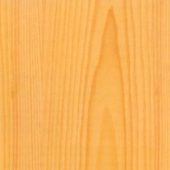Fir (Abies alba)
Pine/softwood from the Conifer family (Pinaceae).
Other names: Silver Fir, European Silver Fir.
Natural range
Firs (Abies) are a species of coniferous tree in the Conifer family (Pinaceae). There are altogether about 50 different species of fir, which are all found in the temperate zone of the northern hemisphere. After the pines, (Pinus) firs are the most widespread and have the most species of all the Conifer family.
Description of the wood
There is no difference in colour between heartwood and sapwood (mature trees). The wood is cream to light grey with reddish to reddish grey latewood rings. It has no resin ducts and the rays are scarcely visible.
Fir timber is heavier than spruce with a basic density r15 of 0.50 g/cm³.
Workability
Fir timber is easy to work with all kinds of tools, especially saws. It cuts well but is also liable to split. The surface is more difficult to stain than that of spruce.
Durability
Fir is not resistant to wood-destroying fungi (durability class 4 acc. to EN 350-2) and susceptible to infestation by wood-destroying insects.
Treatability
Fir tree heart and sapwood are easy to treat (treatability acc. to EN 350-2).
Applications
Fir timber is used in much the same way as spruce: as constructional timber, for furniture and for paper production. Due to the lack of resin, the fir is a particularly sought-after constructional wood. Its decorative grain makes it ideal for doors - both exterior and interior – and for windows. Special uses are in water engineering, for which fir timber is highly durable, and – as it is odourless – for making fruit and vegetable crates. Fine-ringed fir wood has good resonant properties and is used as “tonewood” in musical instruments and organ pipes. Fir trees are also the classical Christmas trees. The Nordmann fir in particular is cultivated in plantations for this very purpose. Decorative brushing, too, is made from fir trees, and, finally, fir wood is also in great demand as a heating fuel.
